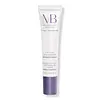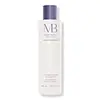What's inside
What's inside
 Key Ingredients
Key Ingredients

No key ingredients
 Benefits
Benefits

 Concerns
Concerns

 Ingredients Side-by-side
Ingredients Side-by-side

Water
Skin ConditioningOleyl Erucate
EmollientGlycerin
HumectantDimethicone
EmollientHydrolyzed Hazelnut Protein
Skin ConditioningCetearyl Alcohol
EmollientCeteth-20 Phosphate
CleansingSteareth-10
EmulsifyingSorbitan Stearate
EmulsifyingPalmitoyl Grape Seed Extract
Skin ConditioningCucumis Melo Fruit Extract
Skin ConditioningSafflower Oil/Palm Oil Aminopropanediol Esters
Skin ConditioningAloe Barbadensis Leaf Juice
Skin ConditioningHydrogenated Phosphatidylcholine
EmulsifyingCholesterol
EmollientBisabolol
MaskingSodium Hyaluronate
HumectantAlcohol
AntimicrobialCaprylyl Glycol
EmollientEthylhexylglycerin
Skin ConditioningBiosaccharide Gum-4
Skin ConditioningHydrogenated Vegetable Oil
EmollientMagnesium Ascorbyl Phosphate
AntioxidantDicetyl Phosphate
EmulsifyingAcrylates/C10-30 Alkyl Acrylate Crosspolymer
Emulsion StabilisingMicrocrystalline Cellulose
AbsorbentCellulose Gum
Emulsion StabilisingDisodium EDTA
Sodium Hydroxide
BufferingBenzoic Acid
MaskingChlorphenesin
AntimicrobialPhenoxyethanol
PreservativeMica
Cosmetic ColorantWater, Oleyl Erucate, Glycerin, Dimethicone, Hydrolyzed Hazelnut Protein, Cetearyl Alcohol, Ceteth-20 Phosphate, Steareth-10, Sorbitan Stearate, Palmitoyl Grape Seed Extract, Cucumis Melo Fruit Extract, Safflower Oil/Palm Oil Aminopropanediol Esters, Aloe Barbadensis Leaf Juice, Hydrogenated Phosphatidylcholine, Cholesterol, Bisabolol, Sodium Hyaluronate, Alcohol, Caprylyl Glycol, Ethylhexylglycerin, Biosaccharide Gum-4, Hydrogenated Vegetable Oil, Magnesium Ascorbyl Phosphate, Dicetyl Phosphate, Acrylates/C10-30 Alkyl Acrylate Crosspolymer, Microcrystalline Cellulose, Cellulose Gum, Disodium EDTA, Sodium Hydroxide, Benzoic Acid, Chlorphenesin, Phenoxyethanol, Mica
Water
Skin ConditioningPropylene Glycol
HumectantCetyl Alcohol
EmollientStearyl Alcohol
EmollientSodium Laureth Sulfate
CleansingSodium Laureth-8 Sulfate
CleansingMagnesium Laureth Sulfate
CleansingMagnesium Laureth-8 Sulfate
CleansingSodium Oleth Sulfate
CleansingMagnesium Oleth Sulfate
CleansingGalactaric Acid
Ethylhexylglycerin
Skin ConditioningSodium Hydroxide
BufferingCaprylyl Glycol
EmollientHexylene Glycol
EmulsifyingPhenoxyethanol
PreservativeWater, Propylene Glycol, Cetyl Alcohol, Stearyl Alcohol, Sodium Laureth Sulfate, Sodium Laureth-8 Sulfate, Magnesium Laureth Sulfate, Magnesium Laureth-8 Sulfate, Sodium Oleth Sulfate, Magnesium Oleth Sulfate, Galactaric Acid, Ethylhexylglycerin, Sodium Hydroxide, Caprylyl Glycol, Hexylene Glycol, Phenoxyethanol
Alternatives
Ingredients Explained
These ingredients are found in both products.
Ingredients higher up in an ingredient list are typically present in a larger amount.
Caprylyl Glycol is a humectant and emollient, meaning it attracts and preserves moisture.
It is a common ingredient in many products, especially those designed to hydrate skin. The primary benefits are retaining moisture, skin softening, and promoting a healthy skin barrier.
Though Caprylyl Glycol is an alcohol derived from fatty acids, it is not the kind that can dry out skin.
This ingredient is also used as a preservative to extend the life of products. It has slight antimicrobial properties.
Learn more about Caprylyl GlycolEthylhexylglycerin (we can't pronounce this either) is commonly used as a preservative and skin softener. It is derived from glyceryl.
You might see Ethylhexylglycerin often paired with other preservatives such as phenoxyethanol. Ethylhexylglycerin has been found to increase the effectiveness of these other preservatives.
Phenoxyethanol is a preservative that has germicide, antimicrobial, and aromatic properties. Studies show that phenoxyethanol can prevent microbial growth. By itself, it has a scent that is similar to that of a rose.
It's often used in formulations along with Caprylyl Glycol to preserve the shelf life of products.
Sodium Hydroxide is also known as lye or caustic soda. It is used to adjust the pH of products; many ingredients require a specific pH to be effective.
In small amounts, sodium hydroxide is considered safe to use. However, large amounts may cause chemical burns due to its high alkaline.
Your skin has a natural pH and acid mantle. This acid mantle helps prevent harmful bacteria from breaking through. The acid mantle also helps keep your skin hydrated.
"Alkaline" refers to a high pH level. A low pH level would be considered acidic.
Learn more about Sodium HydroxideWater. It's the most common cosmetic ingredient of all. You'll usually see it at the top of ingredient lists, meaning that it makes up the largest part of the product.
So why is it so popular? Water most often acts as a solvent - this means that it helps dissolve other ingredients into the formulation.
You'll also recognize water as that liquid we all need to stay alive. If you see this, drink a glass of water. Stay hydrated!
Learn more about Water